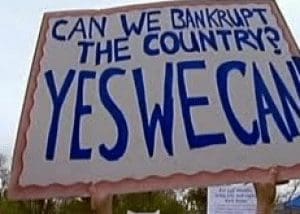 If the U.S. ends the coming weekend without national debt limit deal, it won’t just be bond defaults sending the nation back into a deep, ugly recession. A hint came Tuesday as the price of oil rose a little, nearing $100 a barrel once again even as stocks did a mini-tank, with the Dow down 91 points.
If the U.S. ends the coming weekend without national debt limit deal, it won’t just be bond defaults sending the nation back into a deep, ugly recession. A hint came Tuesday as the price of oil rose a little, nearing $100 a barrel once again even as stocks did a mini-tank, with the Dow down 91 points.
So who’s still grinning as most of us curse the absolutists in Congress who see “balance” as treason? Yep, oil companies.
BP jumped back to a $5.6 billion quarterly profit Tuesday after a $17 billion loss a year ago, post-spill. Smaller Occidental Oil was up 71% over last year’s 2nd quarter, to $1.8 billion. And analysts think the party will continue.
From Reuters:
Analysts said it would likely be the oil industry’s biggest second quarter since 2008, when oil prices hit record highs. “We expect almost all the oil and gas companies we cover to report higher earnings than in [2009 and 2010]. The earnings improvements from a year ago reflect higher oil prices of 32% for West Texas Intermediate crude and and 50% for Brent North Sea crude,” said Fadel Gheit, senior energy analyst for Oppenheimer and Co.
Getting oil speculation under control has slipped far from the top of the agenda in Washington. But no matter how the debt crisis turns out, federal regulators have to recognize that the economy can’t ever really recover while Main Street pays for the energy binges on Wall Street and in Houston.
The oil price increase came as the value of the dollar dropped, and speculators hunted for a place to put money coming out of stocks. If the U.S. economy crashed after a debt default, oil would crash partway, because a dead U.S. economy means so much less gasoline and oil consumed. But in a lesser scenario, oil could just keep creeping up, until speculative energy and food prices really do crash the consumer economy again.
No matter what happens, oil will rise long before consumers get out from under their job and other losses–just as happened in the recent recession, putting a drag on any hope of quick recovery.
What to watch? The price of gasoline. Economists see $4.00 gasoline in the U.S. as the tipping point where drivers start feeling pinched and cut back on other expenses. Gasoline is now hovering around a national average of $3.70 a gallon, up 15 cents from a month ago. That’s not much of a cushion; it’s already more than job-hunters can afford. Too bad no one in the Capitol has lost his job and can feel the pain firsthand.



